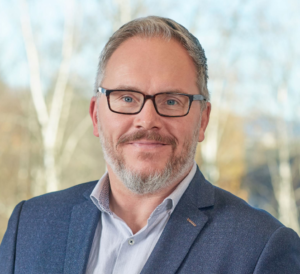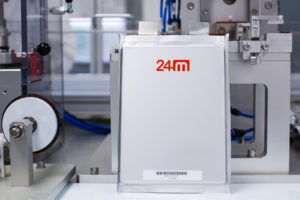June’s SMMT International Update features guest writer Tom Einar Jensen, CEO at FREYR Battery.
In the run-up to the Electric Vehicle Symposium in Oslo, SMMT spoke to Tom Einar Jensen Chief Executive Officer and Co-Founder of Freyr, to hear about the company and their plans to build Norway’s first Gigafactory.
Tom talks about FREYR’s strategic tenets of speed, scale and sustainability and how they settled on the Mo i Rana industrial complex, the location of their battery plant. Tom also explains how FREYR will build the cleanest batteries in the world, using renewable energy and having a zero-waste policy, based on Nordic principles. Tom also shares his view on the Norwegian EV market and the opportunities he sees to work with UK companies. We had an interview with CEO Tom Jensen in the Norwegian battery company FREYR Battery about everything from FREYR’s founding to its potential in the UK market.
Please introduce Freyr to us.
Tom: The concept for FREYR emerged back in 2017, with founders who had a long track record in Norwegian energy and energy-intensive industry. FREYR has been moving fast ever since and we now plan to develop up to 43 GWh of battery cell production capacity by 2025 to position the company as one of Europe’s largest battery cell suppliers. Our first planned facilities will be in Northern Norway, leveraging Norway’s highly skilled workforce and abundant, low-cost renewable energy sources in a crisp, clear and energized environment. FREYR aims to supply safe, high-energy density and cost-competitive clean battery cells to the rapidly growing global markets for electric vehicles, energy storage, and marine applications.
FREYR went through the traditional start-up journey, asking ourselves a range of questions like: what is the business plan? What is the value proposition? What technology are we going to build? Who should we recruit? And how do we fund the development of the company and what are the stages? Typically, you answer these questions by doing some initial pre-feasibility studies, and you look around for locations in Norway that could be suitable. That’s how we landed in Mo i Rana – which is where one of Norway’s most modern industrial parks is located. The industry and the society there are built up to support industry and a renewable future.
So, when we came to that area, and we saw the industrial locations that were available, and we knew that this region has up to five to six terawatt-hours of annual surplus, renewable, low-cost electricity. We felt that this was a match made in heaven.
We believe that there are three things that matter when it comes to being successful as a battery company, which is why our strategy is based on these three strategic tenets: speed, scale and sustainability.
Everything we do, and I repeat this, everything we do, is filtered through that. If it doesn’t contribute to speed, if it doesn’t bring scale, or if it isn’t sustainable, we don’t do it. So, it’s as simple as that.
Then we started to evaluate different technologies that we believed could have a reasonable ability to work. We met with the incumbents, including several of tier one producers. We were in Japan, we were in China, we were in South Korea, and we met with a number of companies in Europe. We also visited several companies in the US. This was all pre-COVID. And beyond the Asian producers, there aren’t that many producers out there. We were looking for three things. We were looking for technology. We were looking for something that had already been commercially introduced because we didn’t want too much technology risk, and we were looking for something that could offer the potential for a step-change in performance and cost, which are two sides of the same coin.
FREYR plans to build Norway’s first Gigafactory. Why was Norway your location of choice?
Tom: Industry is part of Norway’s DNA. This is due to the country’s history in building and exporting energy in various forms, either directly or indirectly, through energy-intensive products, which of course, over time, has resulted in a fairly extensive process. As Norway is blessed with an abundance of natural resources, it is little surprise that around 95% of all energy and energy-related products that are produced in Norway are exported. As a country, it is a small, open economy, which successfully leverages its abundant natural wealth.
Norway is also a hydropower base which was built up because we are a mountainous country, so we can dam up a lot of our lakes and rivers and create a lot of hydropower. That has formed the backbone of the close to 100% green electricity we have in Norway. This electricity is also cost-competitive because you already have availability of surplus, renewable energy. And in a world that is increasingly going towards decarbonisation, and doing so at an accelerated pace, that advantage gives us a very strong starting point.
Battery production requires not only the natural facilities but also process-intensive industrial skills and energy-intensive industrial skills, both of which are rife in Norway.
Which markets will FREYR serve?
As for potential markets, we aim to produce batteries for all relevant markets, not only the Norwegian market.
First and foremost, we will sell to storage applications. The main reason for this is that the relative competitive advantage of our technology is greater in the storage application market than what it is in EV applications, even though we also may have competitive advantages there. So, it’s clear that this technology is also meant for primetime EV application in the future.
My electrochemical friends will not agree with me, but in layman’s terms, there isn’t that much of a difference between the batteries whether it’s storage application or EV applications, at least not from a production standpoint. The electrochemical composition might be different, or maybe the configuration of the battery is different. But by and large, you’re taking metal powder, you’re mixing it into a slurry, and you’re casting it onto these current collectors. Then you ship it off. It’s a basic process.
Building a sustainable and ethical supply chain is a key challenge for all manufacturers – what is FREYR’s strategy?
We want to produce the cleanest battery solutions in the world. That’s kind of a qualitative statement. What that means in quantitative terms is that our ambition is to urgently reduce the carbon footprint on the lifecycle basis by more than 80%, compared to global averages.
The way in which we’re going to do this is first and foremost by using renewable energy in the production of the battery cells themselves, which is a big part of our ambition. The second part is to locate active material production in a low-carbon energy environment because that is the second most important part of reducing the C02 footprint. The third part is to take the remaining most energy-intensive inputs into a battery cell and enable them to be produced in an area with low-carbon electricity. And the fourth part is ensuring that our packaging and recycling is done according Norwegian or Nordic principles, which also represents a significant potential reduction to our C02 footprint by as much as 80% compared to global averages.
Now, we want to go beyond that. We want to take on the harder-to-abate parts of the value chain – the remaining 20%. Our long-term ambition is, of course, to not rely on carbon offsets and things like that. Already Swedish mining companies are using machines that are electric, as opposed to diesel generated. More and more marine applications are being electrified and or converted to hydrogen or some sort of other renewable solution. When transporting lithium from South America to the Nordic Region, it’s hard to imagine that this entire sea journey will be powered by batteries anytime soon. But if we able to source ore, minerals and metals closer to where we’re producing it, we may be able to cut carbon levels.
My final point on this is that we have a zero-waste policy at FREYR. Our ambition is to have minimum waste in our facilities and zero emissions to air. Furthermore, every material we must scrap in our facilities will be recycled back into second use, and our technology makes that possible to a larger extent than conventional processes.
There is huge demand for batteries across Europe and world-wide, do you plan gigafactories in any other locations?
We do indeed. The plan is to build up the footprint and the blueprint, so to speak, in Norway. We’re going to learn how to do it in the best way we can in Norway. We’ve already established white labelling as the blueprint for a modularized system. We’ve secured acreage in Vaasa in Finland. We are working with Koch Strategic Platforms on a site selection process in the US, where we have more than 130 interesting locations. So, now we’re doing the narrowing down of that funnel by putting it through various filters.
It has also previously been announced that we’re looking into Sweden, an area outside of Gothenburg called Svenljunga. We’re looking at other locations in Europe as well. At the end of the day, we believe that there will be certain degree of geographical concentration of these battery facilities. We don’t necessarily subscribe to the idea of one facility in each country. Each country will want to have security of supply and will tend to say that batteries are a critical part of the energy infrastructure. So, we are a bit agnostic about this. Of course, our cluster-based thinking – the belief that R&D hubs, raw material hubs and so on will develop around large production facilities – makes sense from a scale point of view. But at the same time, you can establish hubs of raw material production in one area, and then you can have conversion of those raw materials into battery cells potentially be more dispersed. And then recycling likely has other sorts of location factors that determine where those facilities will be.
Norway is well known for already having a very high penetration of Electric Vehicles. Do you see any challenges down the road towards 100% zero emission market share?
One challenge that arose here recently was when the VAT exemption enjoyed by electric vehicles owners was slated to be removed, at least for certain more expensive cars. It is not clear whether this will be a big deterrent or not. I would support the Electric Vehicle Association in Norway saying, ‘don’t remove something that has worked quite well’. At the same time, 94% of new vehicles sold in Norway by March 2022 to private consumers were EVs. We also see that the EV models that are being introduced are much sexier; they are cooler and the range is not really an issue anymore. Right now, this wave is too strong, and it won’t slow down in any material way. Will you have temporary blips a little bit here and there? Yes, I think so. The Norwegian government has the ambition of that by 2025, all new vehicles should be zero emission. So, we only need around three percent (increase) per year to get there. And that’s not going to be challenging.
But how quickly we can ensure that we have sufficient charging infrastructure is obviously another question entirely. We are already seeing that most of major gasoline stations are including charging stations. The average electric vehicle is idle most of the time. So that means that you basically have a mobile energy device on wheels. What you will see emerging, in my opinion, is bi-directional charging. We are all used to thinking about intelligent charging systems, so that we only charge up our vehicle when we’re plugged into our house in the middle of the night when the price is the lowest. But what we’re not thinking about yet is charging the energy that we have in our vehicle back to the grid when the price is high. And that is already happening. There are a lot of start-ups emerging around this in the US and UK and other places. And I think the implementation of such systems may come first in Norway, just because we have the largest fleet of these mobile power plants which can be optimised.
What’s your impression of the UK market, do you see opportunities for FREYR? 
We are a partnership-based organisation, so we don’t pretend to be experts on things we don’t know how to do. We would like to team up with the best and the brightest. If there are companies in the UK, be it car manufacturers, stakeholders in supply chain, or initiatives in battery cell manufacturing. Are we interested in dialogue? Absolutely. The best way to scale this industry is by cross collaboration and cross pollination between different stakeholders – the ten-folding of capacity in very short order is a gargantuan task, if I can use such a such an expression. And if we do not collaborate, we won’t succeed. It’s as simple as that.
We have developed an approach in which we reduce a 15 to 17 step production process down to just five. In turn, the production footprint is 80% smaller and capex is lower. This means that you can start thinking about building at gigawatt-hour scale facilities in places where you previously didn’t think you could build them. You may build them closer to where the car manufacturers are, as you don’t need as huge a greenfield area. So many of the challenges that conventional battery producers face may become more manageable.
In addition, all battery producers, at the point when they start to produce batteries, have a lot of headaches. We are building a customer qualification plant, which will test parts of the production equipment of a normal production line in commercial operations. The reason for this is to create sample sales for our customers. It’s to test different materials over time. It will also act as a training ground for operators, so that when we start up our commercial facilities, we hope to have overcome most of the challenges already.
We believe we have found the right technology and we are developing it at industrial scale at what we believe is one of the best locations in the world. We also believe that we have the best people because of the regions where are present, and because we just tend to think that way. But we are also importing a lot of expertise internationally. If this becomes successful, all the areas we originally scouted become viable options for growth opportunities.












